|
|
|
Sort Order |
|
|
|
Items / Page
|
|
|
|
|
|
|
| Srl | Item |
| 1 |
ID:
131039
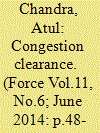

|
|
|
|
|
| Publication |
2014.
|
| Summary/Abstract |
India's growing civil aviation sector now has an increasing number of scheduled, non-scheduled airlines, flying institutes and private-use aircraft that will require a larger number of airports and airfields to enable air connectivity across all corners of the country.
The Airports Authority of India (AAI) had already begun work on 50 low-cost airports, located in remote and interior areas of the country. In addition to this greenfield airports at Navi Mumbai, Goa, Kannur and Kushinagar, AAI has identified six airports for private management under the Public Private Partnership (PPP) route following the successful implementation of PPP models in Delhi, Mumbai, Bengaluru, Hyderabad and Cochin.
All these measure will not only lead to more airports but also increased utilisation of existing airports, thus helping to increase air traffic but at the same time putting additional pressure on airspace management. In another recent move, the government allowed flexi use of airspace by civil and military users on a sharing basis, which will enable the available airspace to be used in a more optimised and effective manner.
|
|
|
|
|
|
|
|
|
|
|
|
|
|
|
|
| 2 |
ID:
131048
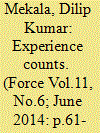

|
|
|
|
|
| Publication |
2014.
|
| Summary/Abstract |
One of the most uncomfortable questions that stare in the face of Appointments Committee of the Cabinet (ACC) is whether an IPS officer with a career-long experience in state police force can lead a central paramilitary force. Even within the central paramilitary forces, the tasks and objectives of the Central Reserve Police Force (CRPF) and the border guarding forces are different. Furthermore, among the border guarding forces, Indo-Tibetan Border Police Force (ITBP) functions differently than the Border Security Force (BSF) or the Sashastra Seema Bal (SSB) or Myanmar Border for that matter. So, shouldn't ACC consider the experience of the officer with a particular force before appointing him to its top position?
|
|
|
|
|
|
|
|
|
|
|
|
|
|
|
|
| 3 |
ID:
131038
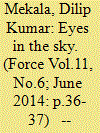

|
|
|
|
|
| Publication |
2014.
|
| Summary/Abstract |
In August 2013, India successfully launched its latest dedicated defence satellite GSAT-7. Planned to serve as an exclusive defence satellite for the Indian Navy, the satellite, as Indian Space Research Organisation (ISRO), boasted of its safety and reliable communication. Although ISRO, which is popularly seen as a civilian space agency, could not openly accept the defence usage of this satellite, analysts claim that this satellite will serve as a force multiplier and help navy in networking all its warships, submarines and aircrafts with its ground based assets. The satellite will help the Indian Navy strengthen its blue water combat capabilities. This advanced multi-band communication satellite was launched by Ariane-5 launch vehicle of Arianespace from Kourou, French Guiana.
|
|
|
|
|
|
|
|
|
|
|
|
|
|
|
|
| 4 |
ID:
131042
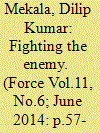

|
|
|
|
|
| Publication |
2014.
|
| Summary/Abstract |
If the Ministry of Home Affairs (MHA) were to be believed, the paramilitary forces fighting the internal security battle - especially in the Red Corridor - were provided with the best equipment. The paramilitary personnel, however, think otherwise. Either it is inadequate number of weapons and systems, or inefficient training; till now the paramilitary forces have not been able to handle the security situation in the Naxal stronghold areas. Latest in the long list of disappointments were the incidents of Naxal attacks during the General Elections.
On April 12, Bastar and Bijapur districts in Chhattisgarh witnessed Improvised Explosive Devices (IED) blasts during the voting season. Maoists triggered landmines in these two areas which claimed the lives of seven polling officials and five Central Reserve Police Force (CRPF) personnel. Three days later, another blast was carried out which killed three security forces. On May 11, seven cops were killed in yet another landmine blast in Gadchiroli district in Maharashtra.
When asked for MHA's assessment on these security lapses, a highly placed official in the ministry said that the paramilitary personnel were in the 'election mode', and as a result security vacuum was created. He implied that it was not physically possible to ensure full safety in this so-called 'election mode'. He then tossed over the responsibility and blame on to the director generals (DG) of the paramilitary forces. "The top leadership of the paramilitary forces could have done better by ensuring proper training to their troops," he said. Giving the example of mini-training centres, which were the brain-child of the then DG CRPF Vijay Kumar, the MHA official said that the DGs did not take this idea forward. Apparently, lack of coordinated efforts between the top officials led to the lack of training.
|
|
|
|
|
|
|
|
|
|
|
|
|
|
|
|
| 5 |
ID:
131050
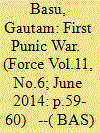

|
|
|
|
|
| Publication |
2014.
|
| Summary/Abstract |
The two leading Mediterranean powers in the post-Greek world clashed in three Punic Wars in the first of which Rome, now master of all Italy, overran Sicily, reinvented itself as a naval power and took its armies beyond Europe for the first time to Carthage in Africa
By the mid-3rd century BC, Romans had secured the whole of the Italian peninsula defeating in about 100 years every rival on mainland Italy. First the Latin League dissolved in the Latin War, then the Samnites were subjugated in three Samnite wars, and finally the cities of Magna Grecia submitted to Rome after Pyrrhus of Epirus withdrew (see FORCE May 2014). Barely decades after the last Pyrrhic War, Rome fought outside Italy for the first time. The First Punic War (264-241 BC) was the first of three fought between Carthage and the Roman Republic for supremacy in the western Mediterranean Sea. It was localised on the island of Sicily but Roman legions also landed on African soil. Carthage, located in today's Libya and Tunisia, was the world's leading naval power at that time. These wars were called 'Punic' from the Latin name for Carthaginians - 'Punici' derived from 'Phoenici' - who traced their origins to the Semitic-speaking peoples of North Africa descending from Phoenician traders of modern Lebanon and who spoke the Punic language. The Second Punic War (218-201 BC) is most remembered in military history for Hannibal's great crossing of the Alps with elephants to do what no man did before: attack Rome overland from the north. The Third Punic War (149-146 BC) involved an extended siege of Carthage, culminating in its conquest by Rome, ending the tale of one of the most illustrious military rivalries in history.
|
|
|
|
|
|
|
|
|
|
|
|
|
|
|
|
| 6 |
ID:
131041
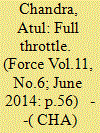

|
|
|
|
|
| Publication |
2014.
|
| Summary/Abstract |
Pratt & Whitney delivered its first ship set of PurePower PW1100G-JM engines on schedule to Airbus last month for its A320neo aircraft family. According to David Brantner, president, Pratt & Whitney Commercial Engines, "Pratt & Whitney has completed more than 75 per cent of certification testing and we are on track to meet or exceed all commitments." The PurePower engine family has now completed more than 9,000 hours of rigorous testing and is on track and ready to power the first A320neo aircraft in late summer, he added.
Compared with an A320ceo without Sharklets, the A320neo powered by PW1100G-JM engines will provide customers with up to a 15 per cent reduction in fuel-burn and a corresponding reduction in CO2 emissions. The PW1100G-JM engine also provides up to a 75 per cent reduction in the A320neo noise footprint, which is environmentally friendly, allowing longer hours of operation at airports that operate under curfew.
The PW1100G-JM engine is currently in the middle of rigorous testing, with certification planned for the second half of this year. Airline operation or entry into service is planned for the fourth quarter of 2015. As of today, the PurePower engine family has received more than 5,500 orders and commitments, including options from more than 50 global customers.
|
|
|
|
|
|
|
|
|
|
|
|
|
|
|
|
| 7 |
ID:
131033
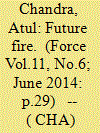

|
|
|
|
|
| Publication |
2014.
|
| Summary/Abstract |
The dismal scenario regarding procurement of artillery guns across various calibres is likely to finally come to an end if the matter is taken up seriously by the new powers that be. If procurements are fast tracked, then it is still a possibility that induction of long range guns and rockets as per the roadmap for Artillery Profile 2027, can be achieved. This would be quite an achievement as trials for 155 mm artillery guns required by the Indian Army began in 2002.
The proposal for the induction of five main types of heavy calibre artillery guns has been stalled for some time now. The Indian Army requires 155mm/52 calibre artillery guns in the following categories: towed gun system, wheeled and tracked self-propelled system and Mounted Gun System (MGS). Of crucial importance in high-altitude areas is the requirement for 145 BAE systems M777 155mm/39 Calibre Ultra-Light Howitzers (ULH), to be acquired through the foreign military sale route from the US. Of these, the M777 is likely to go through first.
Also, to be acquired were indigenously developed systems like the Dhanush 155/45 mm calibre gun and upgraded 130 mm guns. As of 2012, nine regiments had already been equipped with upgraded 130 mm guns. The Ordinance Factory Board (OFB) continues to develop and test the Dhanush 155/45 mm calibre gun. So far, 114 pieces are on order and deliveries for the Dhanush are expected to be completed in the 2018-2020 timeframe. The Request For Proposal (RFP) for upgradation of existing 155 mm/39 calibre FH 77B Bofors to 155 mm/45 Calibre Gun was issued in August 2008.
|
|
|
|
|
|
|
|
|
|
|
|
|
|
|
|
| 8 |
ID:
131040
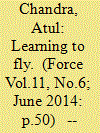

|
|
|
|
|
| Publication |
2014.
|
| Summary/Abstract |
Just over a year ago in July 2013, the High Level Committee on Manufacturing (HLCM) headed by the then Prime Minister Manmohan Singh gave the go-ahead for the manufacture of a civil aircraft in India. The decision was taken with the view that this was "a strategic sector where there was a need to have a presence in the long term, particularly in view of the rapid growth of the aviation sector." As a result "the HLCM took a major strategic decision for the development of a civilian aircraft, of a 70-100 seater range to begin with, in India."
|
|
|
|
|
|
|
|
|
|
|
|
|
|
|
|
| 9 |
ID:
131032


|
|
|
|
|
| Publication |
2014.
|
| Summary/Abstract |
In what is gradually turning into a tradition, six French defence companies, Airbus Group, MBDA, Nexter, Renault Trucks Defense, Safran and Thales (though the first two take pride in being European in composition), in collaboration with the French ministry of defence, invited a group of international journalists on a pre-Eurosatory press tour. The purpose was a single idea across groups: to share news and operational experiences in the lead up to the Show.
Learning from the last such tour, two years back, which was spear-headed by the ministry of defence (MoD) and DGA (Direction générale de l'armement), with the industry playing only a supporting role (which led to unfavourable results for the industry), this time the government stepped back letting the industry run the show the way it pleased. The result was, a short, swift tour focussed on the latest developments pertaining to the chosen products, with minimal background briefings and theoretical lectures.This was made clear by one of the organisers at the first day's reception at Versailles, which is home to Nexter. "We will always have a lot to say," said Laetitia Blandin of Nexter, welcoming the journalists to the company facilities. "But as journalists you will only pick up what makes news for you. So, we decided to focus only on news and cut the rest.
|
|
|
|
|
|
|
|
|
|
|
|
|
|
|
|
| 10 |
ID:
131046
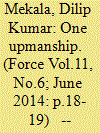

|
|
|
|
|
| Publication |
2014.
|
| Summary/Abstract |
Ever since the border face-off between Indian and Chinese Troops in the Depsang Bulge at the Line of Actual Control (LAC) in April 2013, the Indian Army has raised its pitch to acquire Operational Control of the Indo-Tibetan Border Police Force (ITBP). But that one incident couldn't have been the trigger, and it's not correct to dismiss ITBP's role in handling the situation. After all, the ITBP had followed all international protocols which ultimately led to the solution through diplomatic channels.
The Indian Army cannot be deployed along the forward posts at the LAC according to various UN conventions. So naturally when the Chinese troops entered the Indian territory close to the Burtse post in the Depsang Bulge, the ITBP was the first respondent. According to a source privy to the information, when the Chinese patrol team was observed coming close to the Burtse post, roughly around one-and-a-half or two kilometres away, the ITBP teams responded immediately. As per the Standard Operating Procedures (SOP), the ITBP has to inform all the stakeholders in events such as this. Sources claimed that the information was indeed relayed to all the stakeholders like National Security Advisor (NSA), defence ministry, Indian Army and various intelligence agencies in real time. The ITBP boasts of its quick communication to as many as 11 agencies involved in resolving the stand-off.
|
|
|
|
|
|
|
|
|
|
|
|
|
|
|
|
| 11 |
ID:
131034
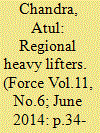

|
|
|
|
|
| Publication |
2014.
|
| Summary/Abstract |
Embraer has managed an outstanding development effort for its first ever tactical military transport, the KC-390. Embraer's efforts are in stark contrast to the Russo-Indian efforts to jointly develop a Multirole Transport Aircraft (MTA) which seems to have stalled since the Preliminary Design Phase (PDP) Contract was signed in December 2012. The first flight of the MTA was to have taken place in 2016, a mere two years away now. The KC-390 on the other hand is expected to make its maiden flight this year.
|
|
|
|
|
|
|
|
|
|
|
|
|
|
|
|
| 12 |
ID:
131037
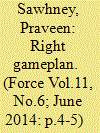

|
|
|
|
|
| Publication |
2014.
|
| Summary/Abstract |
Despite his good intentions and out-of-the-box approach on defence, Prime Minister Narendra Modi will, ironically, be preparing India to fight the last war better. Reason: no one has told the Prime Minister that like other ministries, even defence needs a policy, which he has to formulate, before acquisition of armament begins. Otherwise, it will be putting the cart before the horse. Probably the best thing about making a policy will be that Indian armed forces will be able to do more with less money as the defence services will be compelled to review their capacities, capabilities and doctrines.
In a related development, no government since Independence has been sworn in without a full time defence minister unless the Prime Minister has kept the portfolio with himself. In a first, the Modi government has an interim defence minister, which I would like to believe is how he wanted it. Finance minister, Arun Jaitley, a close confidante of Modi, on assuming additional charge of defence made it known that it is a temporary arrangement. Giving reason for doing so, he said in an oblique fashion that acquisitions are a priority for the government.
|
|
|
|
|
|
|
|
|
|
|
|
|
|
|
|
| 13 |
ID:
131035
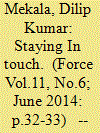

|
|
|
|
|
| Publication |
2014.
|
| Summary/Abstract |
Maritime communication has been one of the most important aspect for navies all across the world. Since modern day combat involves a significant use of naval assets, efficient communication between various ships, submarines, aircraft would place the nation in an advantageous position. Globally, navies constantly update their communication networks which not only provide seamless communication between different maritime assets, but also detect and relay necessary information about the enemy.
The Indian Navy's recent acquisition P-8I has indigenous communication devices manufactured by Bharat Electronics Limited (BEL). Boeing has delivered its fourth P-8I long range maritime reconnaissance aircraft in May, which has BEL's Data Link II communications system, Avantel's mobile satellite system and the Electronic Corporation of India Limited's (ECIL) speech secrecy system fitted onboard. BEL has also provided the P-8I aircraft with its Identification Friend and Foe (IFF) system. The aircraft also has Raytheon's APY-10 surveillance radar that can provide precise information in all weather, day and night missions.
|
|
|
|
|
|
|
|
|
|
|
|
|
|
|
|
| 14 |
ID:
131036
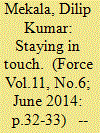

|
|
|
|
|
| Publication |
2014.
|
| Summary/Abstract |
Maritime communication has been one of the most important aspect for navies all across the world. Since modern day combat involves a significant use of naval assets, efficient communication between various ships, submarines, aircraft would place the nation in an advantageous position. Globally, navies constantly update their communication networks which not only provide seamless communication between different maritime assets, but also detect and relay necessary information about the enemy.
The Indian Navy's recent acquisition P-8I has indigenous communication devices manufactured by Bharat Electronics Limited (BEL). Boeing has delivered its fourth P-8I long range maritime reconnaissance aircraft in May, which has BEL's Data Link II communications system, Avantel's mobile satellite system and the Electronic Corporation of India Limited's (ECIL) speech secrecy system fitted onboard. BEL has also provided the P-8I aircraft with its Identification Friend and Foe (IFF) system. The aircraft also has Raytheon's APY-10 surveillance radar that can provide precise information in all weather, day and night missions.
|
|
|
|
|
|
|
|
|
|
|
|
|
|
|
|
|
|
|
|
|